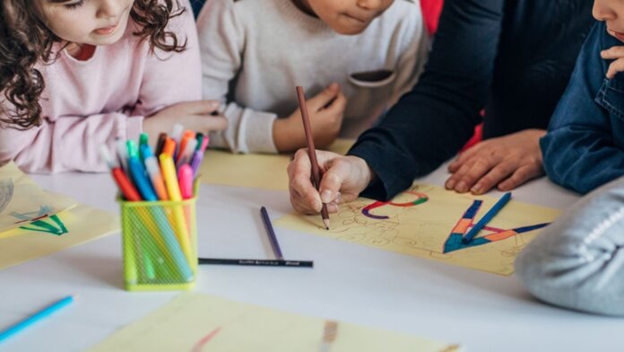
Teaching preschool kids a way to hint letters is an essential step of their early writing journey. At this degree, youngsters are growing high-quality motor abilities, hand-eye coordination, and letter popularity, all of which contribute to their capacity to put in writing independently. However, young novices can quickly become bored if the technique isn’t enticing or if they locate it too tough. To make mastering a laugh and powerful, it’s essential to apply a dependent technique that step by step builds their self belief. One of the first-class approaches to personalize the getting to know enjoyment is via the use of an unfastened PDF device tracing call generator, which allows you to create custom designed worksheets featuring your infant’s call. Name tracing is especially beneficial because youngsters are naturally excited to learn how to write their own names. In this article, we will explore 5 smooth steps to help your preschooler master letter tracing whilst ensuring they live motivated and revel in the process.
Step 1: Start with Large Movements and Sensory Play
Before introducing paper and pencils, it’s important to start with sports that broaden gross motor competencies. These movements assist children with better control over their hands, making it easier to transition to satisfactory motor duties like maintaining a pencil and tracing small letters. Large muscle moves additionally assist preschoolers recognize the fundamental shapes and strokes that shape letters. One effective manner to do that is through air tracing—ask your toddler to apply their finger to “write” letters in the air while saying the letter name out loud. This builds each muscle memory and letter popularity. Another top-notch method is sensory play, which makes learning interactive and amusing. Let your toddler trace letters in a tray filled with sand, salt, or flour. The tactile enjoyment enables strengthening letter shapes and makes exercise extra attractive. Similarly, the usage of shaving cream spread on a desk lets youngsters hint letters with their arms, turning gaining knowledge into a playful pastime. Large chalkboard writing is another first-rate manner to practice large strokes before transitioning to smaller-sized tracing. Additionally, using a free PDF tool tracing name generator can help create personalized tracing sheets for children, making practice sessions more engaging and effective. These activities beef up hand muscles and provide a stable foundation for pencil manipulation.
Step 2: Use Large and Simple Letter Tracing Worksheets
Once kids are cushty with huge actions, introduce them to primary tracing worksheets with bold and properly-spaced letters. At this degree, it’s exceptionally initially uppercase letters due to the fact they may be normally easier to trace due to their instantly traces and simple curves. Instead of straight away giving your baby a pencil, start with thick crayons or markers, which might be easier to preserve and control. Before they use a writing device, encourage them to hint the letters with their fingers first. This step reinforces their understanding of letter shapes and prepares them for extra particular actions. Using a free PDF device tracing name generator, you can create customized call tracing worksheets, which can be fantastically effective because children experience a feel of pride and motivation when getting to know to jot down their personal names. Personalization makes letter tracing extra meaningful and allows children to live engaged. As they gain confidence, introduce them to dotted-line letters, which provide guided tracing without overwhelming them. Repetition and consistency are key at this degree, so encourage them to practice a few letters at a time as opposed to the whole alphabet right away.
Step 3: Introduce Letter Tracing with Guided Lines
As children progress, transition to dependent worksheets that encompass three-line publications (top, center, and backside traces). These courses help preschoolers recognize letter placement and improve their handwriting consistency. When introducing a brand new letter, reveal how to hint it efficiently via displaying the proper stroke order. Worksheets that encompass numbered arrows are useful in guiding kids through the correct letter formation. To keep away from frustration, spoil down the manner into plausible steps—start with letters which have simple straight strains, which include “L,” “T,” and “I,” earlier than shifting directly to curved letters like “C” and “O.” Verbal instructions can also be beneficial. For instance, at the same time as tracing the letter “A,” you may say, “Start at the pinnacle, slide down, slide down once more, and pass inside the middle.” Giving step-through-step verbal cues enables youngsters to internalize the correct way to form letters. Since pleasant motor manipulation is still developing, a few youngsters may also discover it tough to live within the lines. Be an affected person and encourage them, reminding them that practice will make it less difficult over the years. Instead of correcting errors harshly, consciousness is celebrating their efforts, so that it will keep them motivated to keep practicing.
Step 4: Make Letter Tracing Fun with Games and Activities
To save you preschoolers from losing their hobby in tracing, they contain fun sports that make mastering an experience like play as opposed to a chore. Interactive games and creative sports help hold youngsters engaged and enthusiastic about practicing their letters. One exciting pastime is rainbow tracing—inspire your baby to trace every letter a couple of instances using distinct coloured crayons or markers. This repetition reinforces muscle reminiscence whilst making the pastime visually attractive. Another fun technique is dot-to-dot tracing, in which kids connect numbered dots to shape letters earlier than tracing over them. This no longer only improves letter popularity however also enables wide variety sequencing. Another effective recreation is the letter hunt—write letters on sticky notes and disguise them across the room. Once your child finds a letter, they need to hint it on their worksheet. This makes gaining knowledge lively and tasty. Additionally, playdough letter formation is a first-rate palms-on hobby. Ask your infant to roll playdough into letter shapes before tracing them on paper. The texture of the playdough enables strengthening finger muscle mass, making it simpler to keep a pencil for tracing. These kinds of engaging activities assist children companion gaining knowledge of fun, growing their willingness to exercise letter tracing.
Step five: Encourage Independent Writing Practice
Once youngsters emerge as snug with tracing, it is time to transition them toward unbiased writing. At this stage, begin lowering the quantity of tracing courses and inspire them to strive writing letters on their personal. Start with the aid of providing blank areas on worksheets where they could try and write letters without dotted traces. If they struggle, gently draw the letter for them and allow them to trace over it. Using a chalkboard or whiteboard also can help increase self belief, as kids can easily erase errors and attempt again. Daily exercise in real-world situations reinforces writing abilities—encouraging your child to jot down their call on drawings, greeting cards, or small notes. If they’re excited about writing, permit them to scribble freely and test with distinctive letter formations. The key to achievement at this degree is advantageous reinforcement. Praise each strive, even if the letters aren’t best. Avoid complaints, as it can discourage them. Instead, recognition of progress, pronouncing such things as, “Great job! I love how you wrote that letter!” By making independent writing a profitable revel in, children will feel assured and influenced to continue improving their competencies.
Conclusion
Teaching preschoolers a way to trace letters can be a fun and worthwhile revel in while approached with staying power and creativity. By following those five smooth steps, you can assist your child broaden sturdy handwriting talents even as maintaining them engaged within the getting to know procedure. Starting with large moves and sensory play allows build foundational motor abilities, whilst introducing easy worksheets progressively prepares them for established letter tracing. Using guided traces guarantees right letter formation, and incorporating games makes gaining knowledge of a laugh. Finally, encouraging independent writing facilitates preschoolers’ transition from tracing to assured, freehand writing. Personalized worksheets, especially the ones generated through a unfastened PDF tool tracing call generator, upload a unique touch to the studying revel in, making it greater significant in your baby. With constant practice, encouragement, and a playful technique, your infant will soon be tracing and writing letters with confidence!


